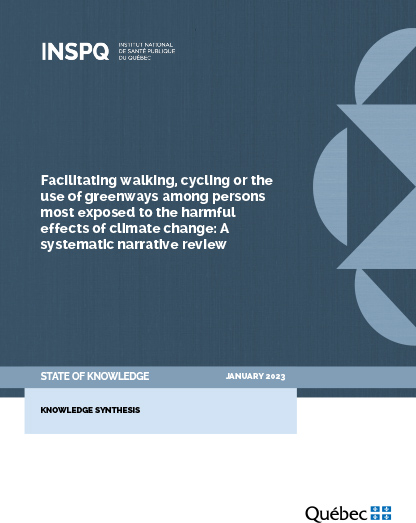Facilitating walking, cycling or the use of greenways among persons most exposed to the harmful effects of climate change: A systematic narrative review
This knowledge synthesis falls within the context of the Villes vivantes project, whose aim is to help municipalities take concrete action to implement local greenways for the benefit of certain population groups that are more likely to suffer the harmful effects of climate change, such as seniors and persons in disadvantaged situations. The predicted increased frequency of episodes of extreme heat and cold resulting from climate change will have an impact on the active modes of transportation practiced by these groups. Based on fifty studies, this synthesis presents a number of individual or personal factors, as well as factors relating to the physical or built environment, or the social, climatic or meteorological environment, that influence active travel and the use of greenways by seniors or those in disadvantaged situations.
- Factors relating to the physical or built environment are the most widely studied in the literature reviewed.
- There is a positive association between pedestrian potential (density, land-use mix, street connectivity, number of destinations) and active travel for both target population groups.
- According to some studies, the absence or poor maintenance of pedestrian and cycling infrastructures can hinder active travel.
- The presence of street furniture (benches, drinking fountains, garbage cans), paved surfaces and flat sidewalks are infrastructure features that encourage active modes of travel for many study participants.
- Winter conditions appear to have a negative impact on the active travel habits of seniors and persons in disadvantaged situations. It is not always cold weather or rain that limits walking or cycling, but rather physical obstacles such as snow or ice on sidewalks or bike paths.
- A number of strategies and initiatives, such as adequate snow clearance, good signage, decorations and illumination of walkways and bike paths, as well as their separation from vehicular traffic, can increase users' sense of security and encourage the use of greenways, even during winter.
- Several studies show that a greater sense of personal safety and an agreeable social environment arising from interpersonal interactions encourage active modes of travel.
- Finally, this knowledge synthesis highlights the beneficial effects of greenways, as infrastructure features capable of encouraging active modes of travel among groups more likely to suffer from the effects of climate change.


